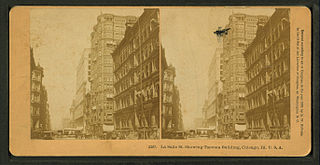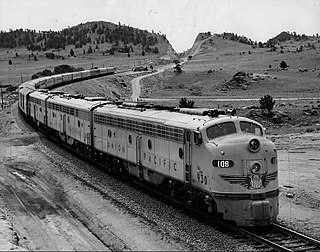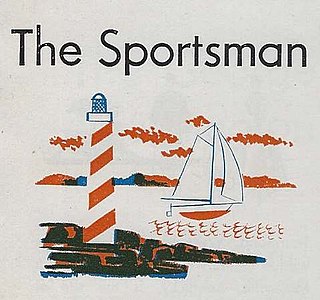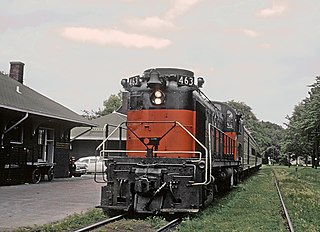
The Chicago, Milwaukee, St. Paul and Pacific Railroad (CMStP&P), better known as "Milwaukee Road", was a Class I railroad that operated in the Midwest and Northwest of the United States from 1847 until 1986.

The Wisconsin and Southern Railroad is a Class II regional railroad in Southern Wisconsin and Northeastern Illinois currently operated by Watco. It operates former Chicago, Milwaukee, St. Paul and Pacific Railroad and Chicago and North Western Railway (C&NW) trackage, mostly acquired by the state of Wisconsin in the 1980s.

The Hiawathas were a fleet of named passenger trains operated by the Chicago, Milwaukee, St. Paul and Pacific Railroad between Chicago and various destinations in the Midwest and Western United States. The most notable of these trains was the original Twin Cities Hiawatha, which served the Twin Cities in Minnesota. The train was named for the epic poem The Song of Hiawatha by Henry Wadsworth Longfellow.

Michigan Services are three Amtrak passenger rail routes connecting Chicago, Illinois with the Michigan cities of Grand Rapids, Port Huron, and Detroit, and stations en route. The group is a component of the Midwest Regional Rail Initiative.

The 400 was a named passenger train operated by the Chicago and North Western Railway between Chicago and Saint Paul, with a final stop in Minneapolis. The train took its name from the schedule of 400 miles between the cities in 400 minutes, and was also a nod to "The Four Hundred Club", a term coined by Ward McAllister to refer to the social elite of New York City in the late 19th century. It was an express train with limited stops between Chicago and the Twin Cities. The "400" ran from 1935 to 1963 on the Chicago to Twin Cities route. The C&NW later named their other passenger trains using the number "400".

The Olympian and its successor the Olympian Hiawatha were passenger trains operated by the Chicago, Milwaukee, St. Paul and Pacific Railroad between Chicago and the Pacific Northwest. The Olympian operated from 1911 to 1947 and was, along with its running mate the Columbian, the first all-steel train to operate in the Pacific Northwest. The streamlined Olympian Hiawatha operated from 1947 to 1961 and was one of several Milwaukee Road trains to carry the name "Hiawatha." The Olympian Hiawatha was designed by industrial designer Brooks Stevens and included the distinctive glassed-in "Skytop" observation-sleeping cars. It later featured full-length "Super Dome" cars.

The architectural firm now known as Holabird & Root was founded in Chicago in 1880. Over the years, the firm has changed its name several times and adapted to the architectural style then current — from Chicago School to Art Deco to Modern Architecture to Sustainable Architecture.

The Challengers were named passenger trains on the Union Pacific Railroad and the Chicago and North Western Railway. The economy service ran between Chicago, Illinois, and the West Coast of the United States. The trains had full Pullman service and coach seating and were an attempt to draw Depression-Era riders back to the rails. Food service was advertised as "three meals for under a dollar a day."

La Crosse station is an Amtrak intercity train station in La Crosse, Wisconsin, served by Amtrak's daily Empire Builder line. The train station was originally built in 1926 by the Chicago, Milwaukee, St. Paul, and Pacific Railroad. The station was renovated in 1997 and today is listed on the National Register of Historic Places in Wisconsin as the Chicago, Milwaukee and St. Paul Railway Depot, as well as the Milwaukee Road Passenger Depot. The La Crosse Rail Bridge, which crosses the Mississippi River, is located just under two miles west of the La Crosse station.
The Sioux was a named passenger train of the Milwaukee Road that operated between Chicago, Madison, Wisconsin, and Rapid City, South Dakota, via Prairie du Chien, Wisconsin and northern Iowa. The train, #11, westbound, and #22, eastbound, operated coaches, dining cars and sleeping cars through most of its history.

The Twin Cities Hiawatha, often just Hiawatha, was a named passenger train operated by the Chicago, Milwaukee, St. Paul and Pacific Railroad, and traveled from Chicago to the Twin Cities. The original train takes its name from the epic poem The Song of Hiawatha by Henry Wadsworth Longfellow. There are a number of Hiawatha-themed names within the city of Minneapolis, the terminus of the original train. The first Hiawatha ran in 1935; in 1939 the Milwaukee Road introduced a second daily trip between Chicago and Minneapolis. The two trains were known as the Morning Hiawatha and Afternoon Hiawatha, or sometimes the AM Twin Cities Hiawatha and PM Twin Cities Hiawatha. The Milwaukee Road discontinued the Afternoon Hiawatha in 1970 while the Morning Hiawatha continued running until the formation of Amtrak in 1971.
The Marquette Golden Avalanche football program, commonly known as the Marquette Hilltoppers from approximately 1940 to 1953 and as the Marquette Warriors from 1954 to 1960, was the intercollegiate American football team for Marquette University of Milwaukee, Wisconsin. The first team was fielded in 1892.

The North Star was a passenger train operated by Amtrak between Duluth, Minnesota and Saint Paul, Minnesota. It originally operated from Chicago, Illinois via St. Paul to Superior, Wisconsin and Duluth, but was soon cut back to a Saint Paul–Duluth train. The service relied in part on funding from the state of Minnesota.

Due to its unique geography, being made of two peninsulas surrounded by the Great Lakes, Michigan has depended on many ferries for connections to transport people, vehicles and trade. The most famous modern ferries are those which carry people and goods across the Straits of Mackinac to the car-free Mackinac Island but before the Mackinac Bridge was built, large numbers of ferries carried people and cars between the two peninsulas. Other ferries continue to provide transportation to small islands and across the Detroit River to Canada. Ferries once provided transport to island parks for city dwellers. The state's only national park, Isle Royale cannot be reached by road and is normally accessed by ferry. The largest ferries in Michigan are the car ferries which cross Lake Michigan to Wisconsin. One of these, the SS Badger is one of the last remaining coal steamers on the Great Lakes and serves as a section of US Highway 10 (US 10). The Badger is also the largest ferry in Michigan, capable of carrying 600 passengers and 180 autos.

The Freeport station of Freeport, Illinois originally served the Illinois Central Railroad. Over the years, the station hosted the Illinois Central's Hawkeye, Iowan, Land O'Corn, and Sinnissippi trains. Passenger service ceased upon the formation of Amtrak in 1971, but resumed between Chicago and Dubuque in 1974 under the name Black Hawk. Service ceased again on September 30, 1981. The depot still stands as a business.

The Varsity was a passenger train operated by the Chicago, Milwaukee, St. Paul & Pacific Railroad over a 140-mile route between Chicago and Madison, Wisconsin.

The Milwaukee Road Depot in Madison, Wisconsin is a railroad depot built in 1903 and operated by the Chicago, Milwaukee, St. Paul and Pacific Railroad. It served numerous passenger trains, including the Sioux and Varsity, and was located next to a major yard, turntable, and roundhouse. The station was one of two Milwaukee Road stations in Madison, and was also known as West Madison station or West Madison Depot to avoid confusion with Franklin Street station on the east side of Madison. All Milwaukee Road passenger service in Madison was consolidated to this station with the closing of Franklin Street in 1952. The Milwaukee Road's service from Chicago to Minneapolis-St. Paul traveled through Milwaukee and central Wisconsin, bypassing Madison to the north. The railroad's competitor, the Chicago and North Western Railroad, offered direct service northwest to Minneapolis.

The Sportsman was a named passenger night train of the Chesapeake and Ohio Railway. It was the Chesapeake & Ohio's long-standing train bound for Detroit from Washington, D.C. and Phoebus, Virginia on the Chesapeake Bay, opposite Norfolk, Virginia. It was unique among C&O trains for its route north from the C&O mainline in southern Ohio. For most of its years it had a secondary western terminus in Louisville at its Central Station.

The Tomahawk was a passenger train operated by the Chicago, Milwaukee, St. Paul and Pacific Railroad between Chicago and Woodruff, Wisconsin. It began prior to 1940 between Chicago and Minocqua, Wisconsin. By 1955, it would be extended to Woodruff before having the terminus cut back to Wausau, Wisconsin by 1958. Service was eliminated by 1968.

Wausau station is a former passenger train station of the Milwaukee Road at 270 Grant Street in Wausau, Wisconsin. Wausau was on the Milwaukee’s Wisconsin Valley division and connected with the main line to Chicago at New Lisbon, Wisconsin. The station gained national attention when Wausau Insurance adopted the station as their corporate logo and launched a nationwide advertising campaign. The station ad first appeared in the January 16, 1954 edition of the Saturday Evening Post. Even after passenger service ended in 1970 the station continued to be featured in television advertising on 60 Minutes. The station gave a national identity to the city of Wausau and the company thrived in a business that is normally dominated by those in major cities. As of 2022 the station is privately owned and is re-purposed as a cocktail lounge while the former baggage building is now a distillery.



















